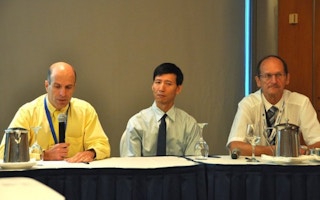For decades, solar companies have been chasing the dream of grid parity. On the sunny island of Singapore in Asia, managing director of Phoenix Solar Mr Christophe Inglin has this to say: “we are nearly there”.
Speaking at the Clean Energy Expo Asia at Suntec City on Tuesday, Mr Inglin shared some figures from Singapore which compared the cost of electricity generated by photovoltaic (PV) means and conventional means such as using fossil fuel.
At grid parity, solar power will cost as much as conventional fossil fuel, allowing it to compete on the market at last. PV is a commonly-used technology that generates solar power worldwide. It converts solar radiation directly into electricity.
Based on Singapore’s data, Mr Inglin said that solar power is becoming a compelling return on investment for the long term: “Certainly a lot better than putting your money in a bank, or government bonds,” he said.
“Singapore would be the first grid parity market. The next one could probably be Thailand,” he noted. “If you add Southeast Asia together, then it’s a fairly big (market).”
He added that the problem with Malaysia and Indonesia is that they subsidise electricity, and PV prices would have to drop even further to reach grid parity.
But reaching grid parity is not enough. Mr Inglin hopes that PV will become even cheaper than conventional electricity so that adopting it becomes a matter of commercial survival for companies.
However, generating solar power efficiently in the tropics remains a challenge due to lack of constant sunlight, presence of shade and harsh tropical conditions.
Two other speakers, Mr Horst Kruse from solar company Schott Solar AG and Dr Jiang Fan from Technology Centre of Energy, Conservation Singapore, also shared their insights on overcoming these challenges.
To ensure that PV solar panels survive the harsh conditions of the tropics, Mr Kruse said that high-quality products are “absolutely crucial”, especially when solar products are now so abundant and the number of panel suppliers is growing fast.
This is because high quality panels would ensure high-energy yield, long service life and low degradation, he added.
Mr Kruse shared other ways to protect the panels in harsh environments. They include double-glass panels, improve testing procedures for panel aging, and proof of salt mist existence for panels near the sea.
Dr Jiang, who is also from Singapore Polytechnic, said that falling leaves and objects such as lamp poles can cast a shadow on the solar panel. Shade will cause solar power output to drop dramatically.
To solve this problem, Dr Jiang Fan recommends more surveys to understand the “solar energy profile” of a particular place. For example, surveyors can take into account the path of the sun and the position the panel to minimise shading. In addition, solar cells should be given the right internal protection such as parallel circuits.
Technology aside, business concerns were raised by an audience member who wanted to know Mr Inglin’s opinion on Singapore’s solar leasing projects in the absence of feed-in tariffs.
Mr Inglin said that leasing was an “excellent idea” because, for companies who do not have enough cash upfront, leasing would provide an extra avenue to reach out to clients, thus expanding the market.
“One thing for sure, they (the government) are not going to do feed-in tariffs in Singapore,” he said. “It’s simply an ideology of not wanting to distort the market with direct subsidies.”
Eco-Business.com’s coverage of Clean Energy Expo Asia 2011, part of Singapore International Energy Week 2011, is brought to you by Schneider Electric.
Click here to read all stories from Clean Energy Expo Asia 2011.










